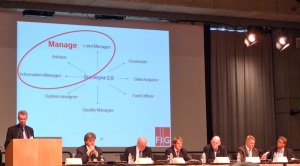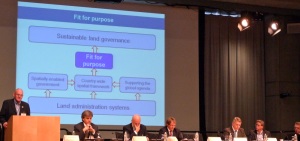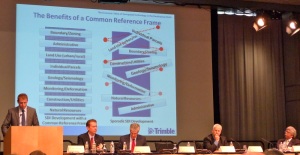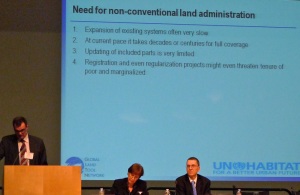Land Governance in a Rapidly Changing Environment - World
Bank Conference
Washington, 23-27 April 2012
The 2012 Annual World Bank Conference on Land and Poverty had record
attendance, over 550 participants from over 85 countries with approximately
350 presentations. This year, the conference proper covered three full days
and including side events and meetings, took up the entire week between 23rd
and 27th April 2012. The venue of the Conference was, once again, the World
Bank Headquarters.
Within this year’s Conference was the World Bank – FIG Joint Segment,
initially called a Geospatial Workshop with the title, Spatial Enabling
Governments and Societies for Sustainable Land Administration and
Management. This segment has subsequently renamed as SEGS (Spatially Enabled
Government and Societies) Workshop with four sessions, each with four
presenters and a roundtable at the end of what was a very long day. As was
mentioned in the Welcome Letter by Klaus Deininger (Lead Economist,
Development Research Group, World Bank), this joint segment was aimed at
“highlighting the rich experience in this area, focusing on approaches that
are affordable and scalable and that can be built upon flexibly as land
values and the need for greater detail increase”.
This year’s Conference was opened by Mr. Justin Lin, Senior Vice
President and Chief Economist at the Bank, and the Opening Session concluded
with a short video address by Former US President Bill Clinton, encouraging the participants to continue striving towards poverty
eradication with various efforts and initiatives whilst addressing various
issues and challenges within the Land Sector. The keynote presentation was
by Prof. Paul Collier, Professor of Economics at Oxford University,
United Kingdom who delivered what was to some, a rather provocative set of
thinking when he expounded on large-scale agribusiness investment in Africa.
He commented on the complexity within the land sector and called for courage
as one work with land within various efforts and initiatives to eradicate
poverty.
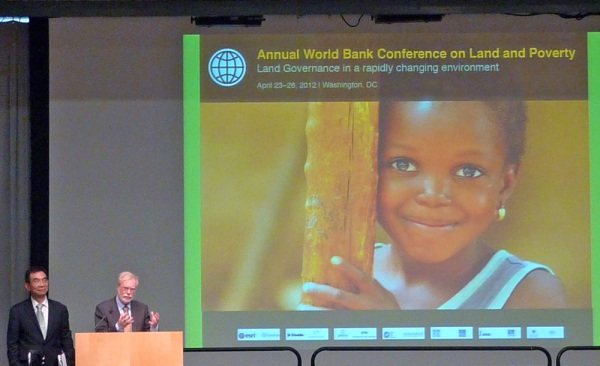
Mr Justin Lin, Senior Vice President and Chief Economist, World Bank and
Prof. Paul Collier, Professor of Economics, Oxford University at the
Conference’s Opening Session
This joint workshop within the conference addresses various and related
issues within the four sessions with the following titles –
- Triple A land administration: from concept to implementation
- Approaches to lower-cost land administration through spatial
enablement;
- Potential and challenges of spatial enablement of land
administration; and
- Spatial enablement to sustainably support the continuum of land
rights.
This year’s conference, the joint workshop in particular, considered what
was fit-for-purpose. Whilst noting that many jurisdictions requires
accurate, assured and authoritative land and property information, yet there
are many jurisdictions need an “initial point of entry” to building these
crucial information. Hence, affordable, applicable and appropriate
approaches are needed instead. When considering the resources and capacities
that are required, this “initial point of entry” may well be at the opposite
end of current approaches and sophistication, and even where participatory
and volunteered land and property information may have a contribution.
Towards the last day of the Conference, we began to hear quips such as
"here in Washington this week, we have consensus that approaches need to be
fit-for-purpose" and this is particularly so when issues such as spatial
accuracies were brought into the equation and the discussions.
It was acknowledged that within land administration and management, there
is a component that is highly technical. This technical component is where
our profession has the competence. We must continue to work to ensure that
our profession do not complicate further that which is already complex,
rather to be looking at more affordable, applicable and appropriate
approaches, taking into consideration context, scale and opportunity. In
this regard, spatially enabling governments and societies not only
contributes towards transparencies and better governance but also could well
deliver these affordable, applicable, appropriate and fit-for-purpose
approaches that will significantly benefit humanity. This was the gist of
the closing presentation by the FIG President as he addressed the audience
on “improving land governance on a broad basis: the professional’s role”.
Spatially enabling Governments and societies for sustainable land
administration and management will require structural changes in the
institutional, legislative and professional domains as well as embracing
open standards, interoperability (systems, institutional and legislative),
culture of collaboration and sharing, avoiding duplication such as mapping
once, use many times, encourage the incorporation of volunteered information
and developing platforms by locating, connecting and delivering information
from difference scales, purposes and origins.
For the World Bank – FIG SEGS Workshop, presenters from amongst FIG
Officers, past and present, included Prof. Stig Enemark, FIG Honorary
President, Christiaan Lemmen (OIRCF), Jaap Zevenbergen
(Commission 7), Robin McLaren, Juerg Kaufmann, John
Whitehead. Daniel Roberge, Chair of FIG Commission 7 chaired one
of the sessions whilst Prof. Stig Enemark moderated the successful
roundtable with Robin McLaren as the rapporteur.
CheeHai Teo
2 May 2012
06 June 2012
|


























